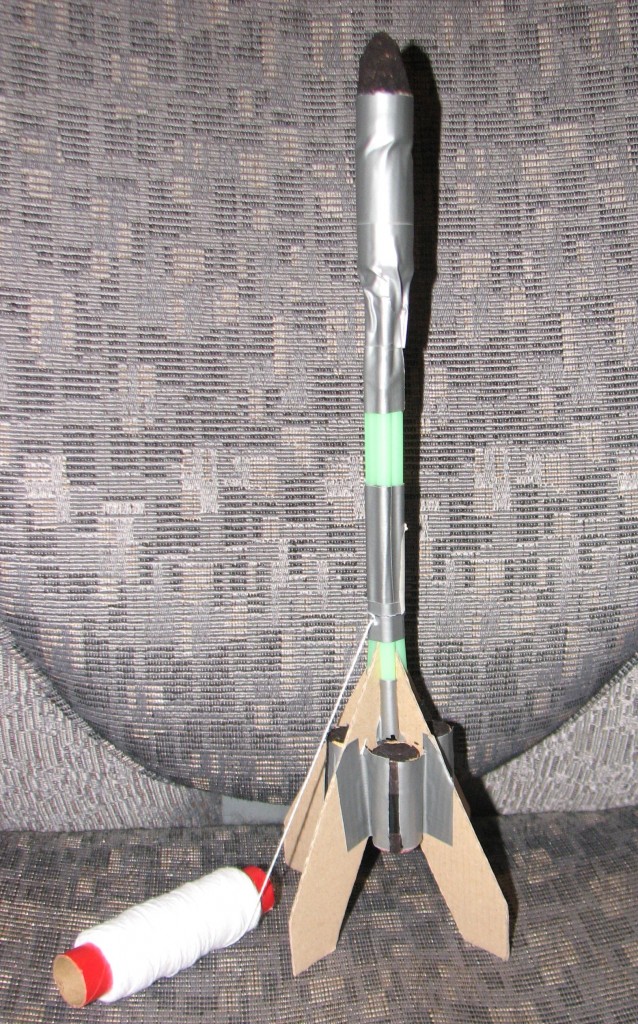Mes amis, I am sorry to have kept you waiting for so long, but I was on a mission to find Honduran cigars. Plus, it was necessary for me to construct an entirely new model rocket with which to demonstrate the function of the fins.
Look now, if you please, at my latest feat of engineering. Does it not look so much more … how do you say, rocketish?
As before, I made everything from soda straws, cardboard, and wine corks, but this time, my friend, Agent Brewer, has supplied me with some of his duct tape. He has also convinced me that aesthetics do have a place, on occasion, in construction that one would otherwise deem to need only functional qualities. The duct tape does, I will admit, have a bit of a metallic sheen that is more appropriate for a rocket than is the masking tape I have been using, although it is by nature more difficult to handle.
The most significant difference between these fins and the fins of my previous model is, but of course, the way these fins are swept to the rear of the rocket. I included the cluster of four engines, as before, because I wanted to set up a worse-case scenario with as much weight to the rear as might possibly be encountered. For such a small craft, however, it would be unusual indeed to find more than one engine for a single stage, or even for a lower stage on multi-stage rockets, although it is not unheard of to find as many as three engines used with such rockets.
See the black nose cone? Did I not carve it quite nicely from a wine cork? The paint is merely the ink from a marking pen. Below the visible nosecone is the other half of the cork, plus another entire cork beneath that. Wrapped with duct tape, it gives the look of an expanded payload section designed to carry some mysterious spy satellite into orbit, or to transport supplies to the space station, does it not? Along the rocket’s fuselage, you see two spots of light green, which is all that remains visible of the four soda straws after I wrapped them with duct tape.
Note the point of attachment of the string, just ahead of the fins. This rocket model, when swung about the head at the end of a few feet of string, will definitely point ahead. But when you first begin to swing it, before the model has had time to come to full speed, it does not do this. Why? We shall come back to that later, mes amis, when we discuss the purposes of launch lugs and guide rails.
The two corks at the nose—well, two corks minus what was necessary to shave off to round the nosecone, at Mr. Brewer’s insistence, were necessary to effect the proper balance of the rocket. Balance? Against what? you may ask.
When I was a boy, on our playground we had swings and slides, as do most playgrounds today, but we also had what was known in America as a teeter-totter. Those of you who are old enough will remember; for the rest, I must explain. Perhaps you have seen the devices used by circus acrobats that consist of a board placed in such a way that when one person stands on one end, and another jumps onto the other end, the first person goes flying into the air. No? Well, no matter. Think of a simple lever, a long board balanced on the edge of a brick, with as much board on one side of the brick as the other. If you push down on one end, the other end goes up, reversing the direction of force. But this sort of lever gives you no mechanical advantage, no increase of force. For that, you must move the balance point, or the fulcrum, as we say, closer to what is being lifted and farther from the person lifting it. But you can also simply add force, or weight, to one end until the other end is raised, as we used to do on the teeter-totter, when one heavy boy was offset at the other end by three smaller children.
The rocket is, in effect, a teeter-totter as it flies through the air. The balance point, our center of gravity, is our fulcrum, our nosecone and payload section represent the small children, and our fins are the heavy boy. The weight of each part of the rocket, including the fins, contributes to the location of the center of gravity. But the surfaces of the rocket, including the fins and all of the fuselage and nosecone, contribute to the center of pressure, that is, the center of the forces applied to the rocket by the air it is passing through. Agent Brewer has informed me that, on a sailboat, this would be called the apparent wind. No matter, let us continue. The fins make up a large portion of the rocket’s surfaces. The larger the fins, and the farther to the rear they are located, the farther back the center of pressure lies. For the rocket to be stable, the center of pressure must be sufficiently behind the center of gravity.
Enough for today. We will revisit this another time. Au revoir.




